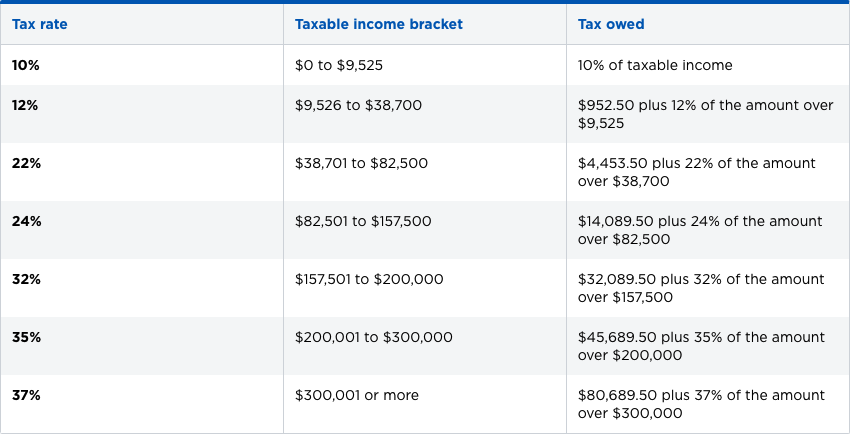Keep up to date on the latest changes in the federal income tax brackets with Brilliant Tax.
In 2018, there are seven federal tax brackets: 10%, 12%, 22%, 24%, 32%, 35% and 37%. The bracket depends on taxable income and filing status.
Our table shows the tax brackets and federal income tax rates that apply to the 2018 tax year and
Single Filers

Married, Filing Jointly

Married, Filing Separately

Head Of Household

How Tax Brackets Work
The United States has a progressive tax system, meaning people with higher taxable incomes pay higher federal income tax rates.
- Being “in” a tax bracket doesn’t mean you pay that federal income tax rate on everything you make. The progressive tax system means that people with higher taxable incomes are subject to higher tax federal income tax rates, and people with lower taxable incomes are subject to lower federal income tax rates.
- The government decides how much tax you owe by dividing your taxable income into chunks — also known as tax brackets — and each chunk gets taxed at the corresponding tax rate. The beauty of this is that no matter which bracket you’re in, you won’t pay that tax rate on your entire income.
- Example #1: Let’s say you’re a single filer with $32,000 in taxable income. That puts you in the 12% tax bracket in 2018. But do you pay 12% on all $32,000? No. Actually, you pay only 10% on the first $9,525; you pay 12% on the rest. (Look at the tax brackets above to see the breakout.)

- Example #2: If you had $50,000 of taxable income, you’d pay 10% on that first $9,525 and 12% on the chunk of income between $9,526 and $38,700. And then you’d pay 22% on the
rest, because some of your $50,000 of taxable incomefalls into the 22% tax bracket. The total bill would be about $6,900 — about 14% of your taxable income, even though you’re in the 22% bracket.

- That’s the deal only for federal income taxes; your state might have different brackets, a flat income tax or even no income tax at all.
How To Get Into A Lower Tax Bracket & Pay A Lower Federal Tax Income Rate
Two common ways of reducing your tax bill are credits and deductions:
Tax credits directly reduce the amount of tax you owe; they don’t affect what bracket you’re in.
Tax deductions, on the other hand, reduce how much of your income is subject to taxes. Deductions lower your taxable income by the percentage of your highest federal income tax bracket. So if you fall into the 22% tax bracket, a $1,000 deduction saves you $220.
In other words: Take all the tax deductions you can claim — they can reduce your taxable income and could kick you to a lower bracket, which means you pay a lower tax rate.
“Being ‘in’ a tax bracket doesn’t mean you pay that rate on everything you make.”
Next Steps…
If you’re ready to file, please feel free to request a free consultation so we can help you take care of your tax filings.
In the longer term, taking steps to reduce your taxable income can go hand in hand with financial planning and for estate planning.
